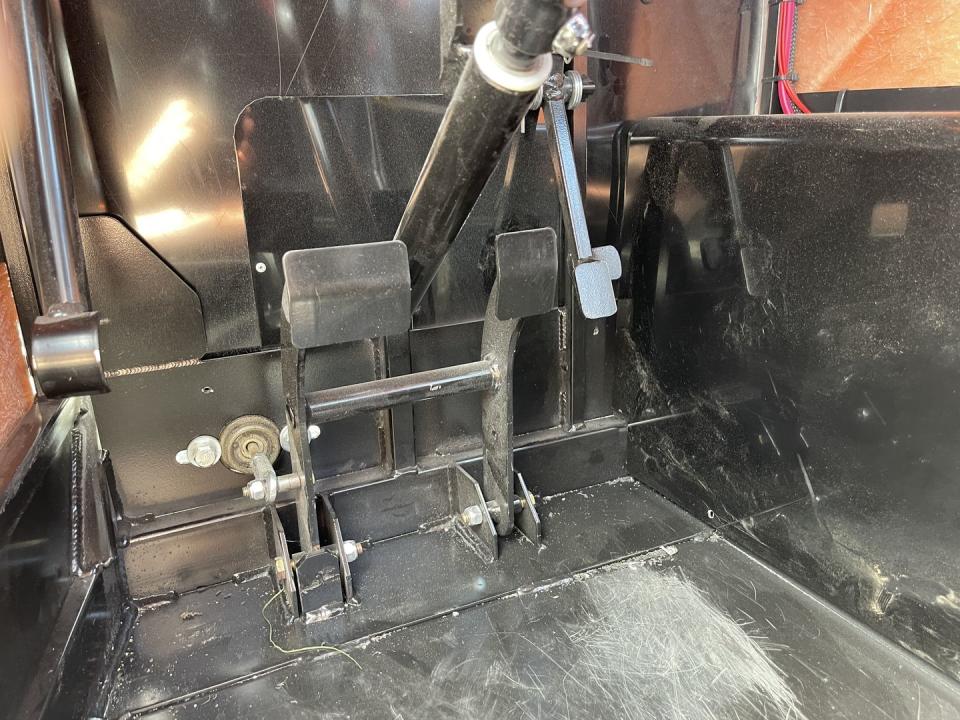Ezra Dyer: Legend Race Cars May Look Goofy But They're Serious Fun

From the October 2022 issue of Car and Driver.
Ignore the goofy body. The Legend car looks the way it does—like a nitromethane Shriner fever dream—because that's the basic shape of a human sitting upright behind a motorcycle engine. Thus the bodywork takes the form of a 1930s Ford or Chevy coupe, 5/8 scale, recalling the prewar bootlegger hotrods that spawned NASCAR. What else could it really look like? Nobody wants to race a Converse All-Star.
But that composite body, cheery and cartoonish, is draped over a real-deal race car. A 12,000-rpm Yamaha FZ09—three cylinders, 847-cc, fuel-injected and water-cooled—drives the rear wheels through a six-speed sequential transmission mated to a locked rear end. The Yamaha makes 125 horsepower in a car that weighs about 1100 pounds (rules stipulate that cars must weigh at least 1230 pounds with the driver after a race). That's a stout power-to-weight ratio to squeeze into a 74-inch wheelbase. Models built before 2018 used larger air-cooled four-cylinder engines with carburetors, 1200 cc or 1250 cc, and those still race alongside the FZ09 cars. The big engines put down a lot more torque, 100 pound-feet at the wheels versus the FZ09's 75 pound-feet, but that doesn't really confer an advantage when you're running 13-inch-diameter bias-ply tires. Traction, not power, is always the limiting factor.
If all that sounds to you like a recipe for good times, I'd agree. So, I ventured to Charlotte Motor Speedway to try a Legend car on the 13-turn infield kart track, which was designed to FIA specifications to host world championship events and is not to be confused with the setup at Jimbo's Go-Karts and Putt-Putt Emporium down at the seedy end of your local beach. At Charlotte, I met Graham Smith, managing director of US Legend Cars International; G.E. Chapman, general manager of the company; and Darren Amidon of Darren Amidon Racing. All three go deep with their knowledge of, and enthusiasm for, these little race cars.
"Legends race in 39 states and 28 countries," Smith tells me as we approach the test car, which wears an unadorned plain white body, Ricky Bobby with no sponsors. "They're big in Finland. And there are series for dirt, asphalt oval, and road course. You can set them up for anything." I suggest ice racing, and it turns out that's been done—just try to keep Swedes from throwing studded tires on a rear-drive car.

Amidon and Anderson help get me belted into the car, which requires some adjustment because the previous driver was a kid. This is one of the few race machines that accommodate a 12-year-old (Young Lions division, ages 12-15) and then an adult racing on the same night. The Masters division, where I would land, is for ages 40-plus and often sees the most ferocious competition. A tachometer is the only instrument, and the quick-release steering wheel is flanked by a thin shift lever to the right. The clutch pedal is far to the left and its pad seems about the size of a quarter, keeping itself out of the way because you only need it to get moving. The brake pedal is shaped like a wide U with the steering column protruding through the middle so that you can brake with either your left or right foot. And that's about it. Smith cautions that the bias-ply Hoosiers will take a few laps to heat up, and I'm sent off to figure the rest out for myself.

 Yahoo Autos
Yahoo Autos 